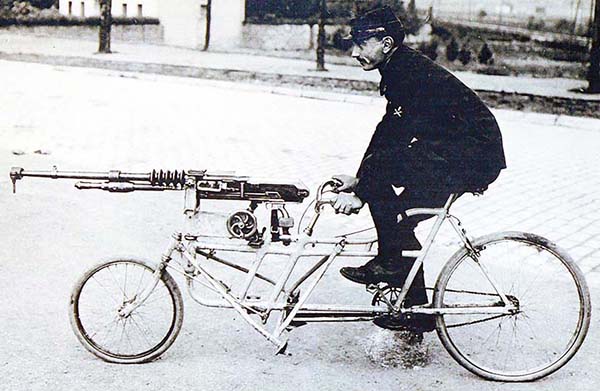By Jean Huon
When the machine gun appeared at the beginning of the last century, researchers were made to enhance, at best, its mobility to keep up with the infantry during attacks.
In Belgium, the army used machine guns on a wheeled carriage towed by dogs.
During WWI, many designers proposed several devices:
- Gounouilou mount (August 1916);
- Mount designed by Captain Colleau from 251st Infantry Regiment (August 1916), several variations exist: No. 1, No. 2 and No. 3. The weight was 7.7 pounds, 6 pounds and 2.2 pounds. The Model 1907 machine gun could not be used with mount No. 2 and No. 3;
- Mount invented by Captain Breche, 39th Infantry Regiment; made with a sole and a support. Weight was 22 pounds (October 1916);
- Lieutenant Fulchiron mount (October 1916);
- Captain Bedu mount, 26.5 pounds (July 1917).
All these mounts were unsteady, and the adoption of the Chauchat light machine gun made them useless.
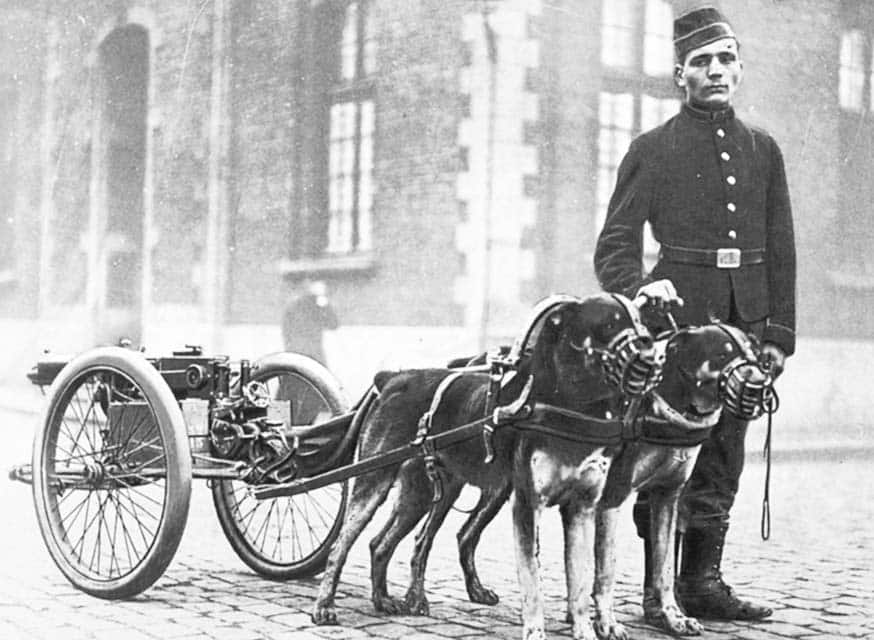
In France, during WWI, an Invention Secretary was set up to register proposals and inventions which could improve the war effort. Ingenious ideas were proposed, beside crazy ones, and the most interesting of them were forwarded to the Commission d’Expérience Auxiliaire de Paris to put them on trial. Many reports on these trials still exist and are kept at the Armament Archive Center in Châtellerault (formerly MAC).
There, we discovered the report pertaining to the test of the Vélo-mitrailleur Blanchard. This vehicle is known since a picture of it was hanging on a wall of the Section Technique de l’Armée de Terre, or Versailles Proving Ground of Versailles established in Camp de Satory, located on a hill 1 mile south of Versailles. The text and the picture were a happy marriage! The idea to set up an automatic gun on a bicycle was not new, since the Italians tried it in 1915, with a twin Villar Perosa submachine gun fixed on the handlebar of a bicycle.
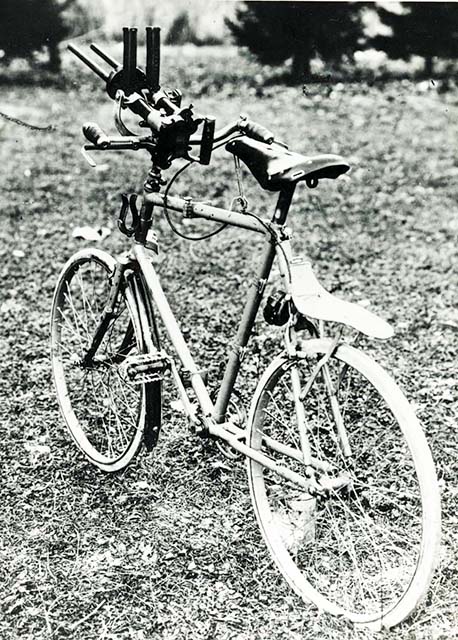
On June 15, 1917, the Commission d’Expérience Auxiliaire de Paris filed a report on the trials of the devices presented by Mr. Blanchard:
- a bicycle with a Hotchkiss M1914 machine gun;
- another to carry ammunition;
- a light mount, nicknamed “toad,” carried on the ammunition carrier bicycle.
Each bicycle was fitted with a stabilizing device which allowed immediate fire after stopping. The “toad” mount was meant to set the machine gun for shooting in a prone position. The mount had two curved sectors, one of them with slots. It was made to have its axis permanently vertical, allowing a mowing (Traversing) fire without any adjustment in height. This device did not exist on the service mounts.
Trials
The first trials were made at Camp de Satory on March 28, 1917, with Major Porteret from the Commission d’Expérience Auxiliaire de Paris; Captain Roux vice-ministry from the Invention Secretary; and Mr. Blanchard, the designer. They went on with an M1907 Saint-Étienne machine gun, with sighting and shooting exercises at 200 meters. Sighting and locking the machine gun proved unsatisfactory, and the designer was asked to improve them. New trials were organized on May 25 and 31, 1917.
The mount could be fitted with the M1907 Saint-Étienne, the M1914 Hotchkiss or the Chauchat light machine gun. The mowing device was improved and now had two hollow sectors joined by a spring-operated brake.
The field trials began with bicycling with soldiers coming from the bicycle section of 1st Cavalry Division. They donned the battle dress of the time: helmet, cartridge pouches, belt, suspenders, coat, rucksack, calf strips and shoes with nails on their soles. They handled two Vélo-mitrailleuses, one with an M1907 Saint-Étienne MG and the other with an M1914 Hotchkiss MG. Another bicycle carried reserve ammunition and the “toad” mount.
After a short warm-up session inside Camp de Satory, the three bicyclists rode to Versailles, up to the entrance gate of the city and then to the Engineer Regiment depot. There the road turns up very steeply. Then, with the Vélo-mitrailleur in hand, they crossed an uneven exercise ground next to the depot, passed over a ditch and over an embankment. After a 100 yards’ run, they drove by the road to the shooting range of “La Minière” and set up the machine guns for shooting. The report says that the handling of the machines was very convenient, and the bicyclists were able to use their equipment easily. After the travel, they were able to set up the machine guns quickly for shooting. But the men complained that the brakes of the bicycles were not efficient.
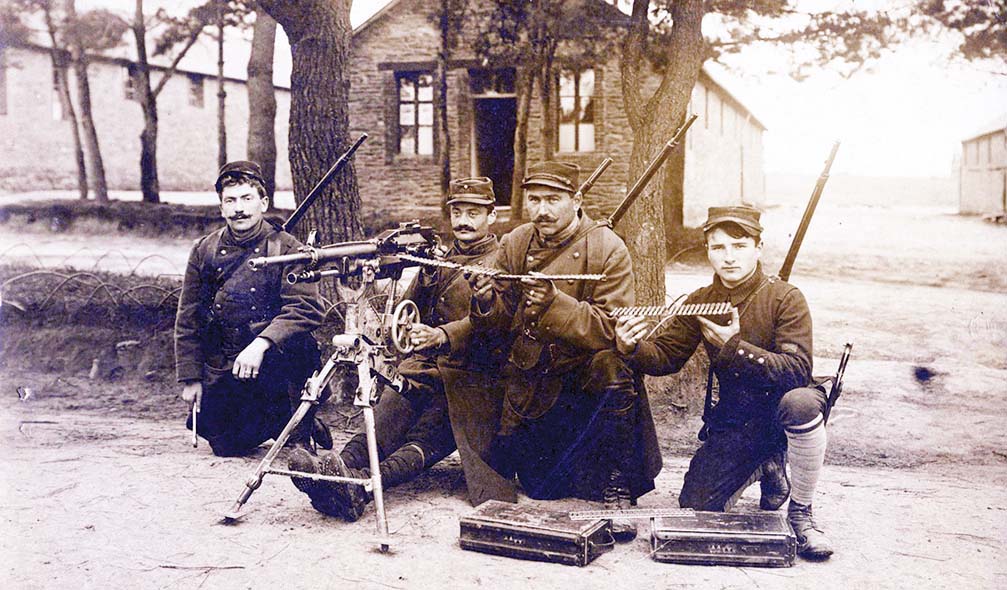
Results
Shooting trials were done on May 31. The results in terms of precision were compared with an M1907 Saint-Étienne MG on the M1915 service mount and the same gun installed on the Vélo-mitrailleur, with 25-shot bursts at 400 meters (437 feet):
- With M1915 mount: the rectangle around impact is 59 inches high and 56 inches wide, at medium rate of fire;
- With bicycle used as a mount: 39”x75”, at medium rate;
- With M1915 mount: 82”x153” at high rate of fire;
- With bicycle: 67”x63”, at high rate.
Several other shots were fired on designated targets. The results of shooting with a gun mounted on the bicycle were similar to those obtained with the service mount, but the shooter had to hold the machine gun firmly.
With the Hotchkiss machine gun, the results on the bicycle were not as good as on the service mount, but they were better when using the “toad” mount.
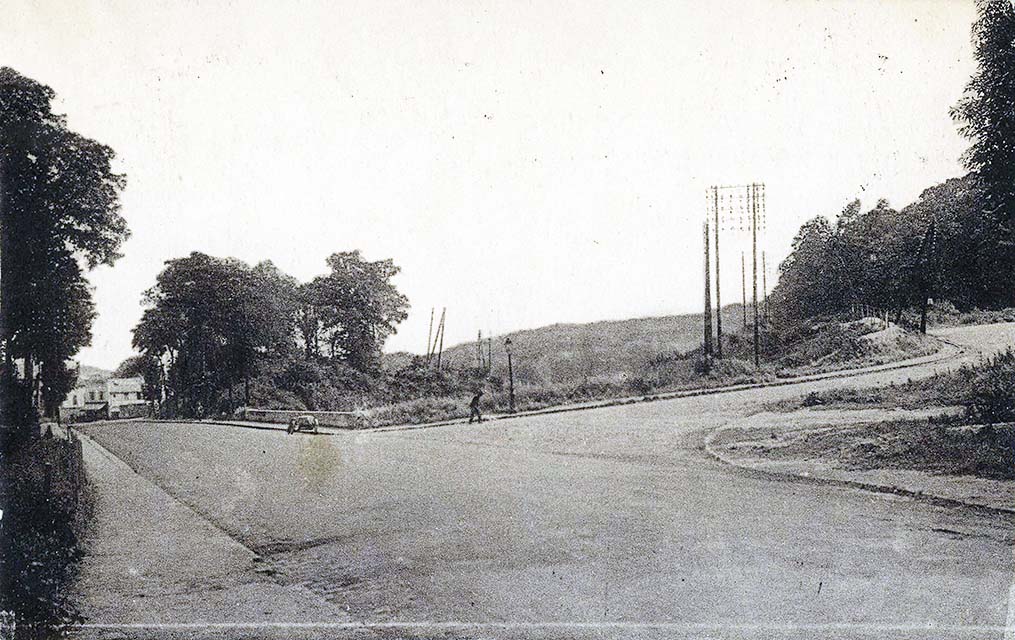
Others trials showed a slight increase in range when using the Vélo-mitrailleur: 100m more between 400m and 800m, and 50m between 800m and 1,000m. These devices were like wheeled mounts and allowed a quick use of any machine gun. The ammunition carrier bicycle was able to carry 300 cartridges and a “toad” mount. Other bicycles could carry accessories and more ammunition. This piece of equipment was an ingenious device and easy to use; the instruction of soldiers was quick and effortless. Shooting results were the same as with an M1915 mount; a slight deviation in height was observed but insignificant.
In his conclusion, the reporting officer writes: “Le Vélo-mitrailleur Blanchard is able [to] fulfill the purpose of its designer: To carry a machine gun with a bicycle and convert it quickly in a steady mount. This equipment can be very useful for the service, and it is has to be presented at the Army headquarters.”
But no answer was given to this suggestion, and nobody heard of the Vélo-mitrailleur Blanchard. New tactics were developed for attacks, and it turned out more efficient to resort to tanks rather than to bicycles for the fire support of infantry assaults!
| This article first appeared in Small Arms Review V24N2 (Feb 2020) |



